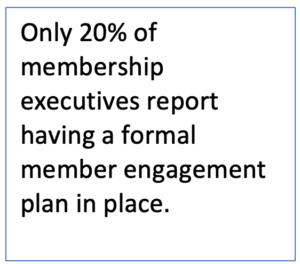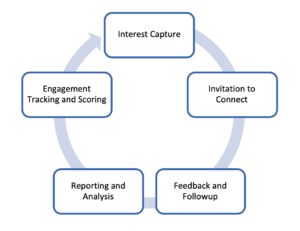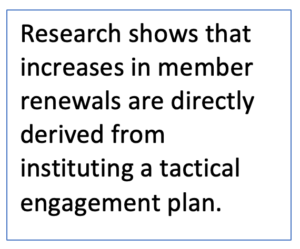Association Member Engagement: Your Path to Retention and Revenue
Professional and trade associations routinely struggle with the acquisition and retention of members. Ultimately, members stay if they believe it is a valuable relationship. The solution? Member engagement through digital transformation is the link between acquisition and retention. Engagement will propel professional association growth through increased member retention and greater interest among non-members to join.
Digital Transformation
Digital transformation is the application of technology to build new business models or processes by leveraging the convergence of people, business and systems. Digital advancements create new product and service opportunities as well as transform business operations, which enables associations and other organizations to improve the member experience, generate more revenue, lower costs and achieve higher levels of efficiency. All of this enables professional and trade associations to spend more time learning about their members’ needs and developing innovative ways to create greater value for each and every one of them.
Organizations that do this well are perceived as a trusted advisor who thrives on exceeding their member’s expectations. Unfortunately, many associations do not know how to use digital technologies to engage their members or how to track engagement at an individual level.
Engagement is a Challenge
Let’s look at the facts. The average individual member association retains 64% of their first-year members, according to Marketing General’s 2017 benchmarking report. The hard reality is that the average total cost to acquire a new member is five times the cost of keeping an existing member. Further, the average total value of a renewed member is worth 36% more than that of the average total value of a newly acquired member. And the average net value of a retained member is 66% greater than that of an acquired member. Do the math: Retention is a financial asset.
 The challenges are real. Membership executives continue to report they are most challenged by an inability to accurately measure member engagement and have inadequate reporting tools, according to Advanced Solutions International (ASI). While executives’ top goals include increasing member retention and engagement, just 20% report they have a formal engagement plan and only 35% saw increases in member engagement (compared to 41% in 2016). Clearly member engagement is declining industry-wide.
The challenges are real. Membership executives continue to report they are most challenged by an inability to accurately measure member engagement and have inadequate reporting tools, according to Advanced Solutions International (ASI). While executives’ top goals include increasing member retention and engagement, just 20% report they have a formal engagement plan and only 35% saw increases in member engagement (compared to 41% in 2016). Clearly member engagement is declining industry-wide.
However, there are often competing priorities that create challenges for senior staff to invest in developing and implementing plans to engage members and create value at an individual level.
Retention Rates Continue to Confound Associations
According to the ASI study, 49% of associations are experiencing a decline in membership and 30% are losing 25% of their members every year. Intuitively, a high churn in members suggests that there is a need to evaluate engagement and value creation.
It is no surprise that higher attrition will have a direct negative financial impact. According to a 2013 study reported by the Harvard Business Review, organizations that design systems to connect the touchpoints and cumulative experience have a 20 to 30% increase in outcomes in terms of higher revenue, better retention, and positive word of mouth.
As members become more engaged with an organization we can logically assume that they are more likely to share their experiences with others. Indeed, a higher level of involvement with the brand community leads to a higher level of customer engagement. In fact, word of mouth is the primary factor behind 20 to 50% of all purchasing decisions and its influence is greatest when consumers are buying a product for the first time. Further, research published in the Journal of Services Marketing finds that word of mouth has a significant positive influence on consumer purchase intention.
The Engagement Solution
What is causing members to leave? All is not lost facing the challenges at hand! In fact, there are five major components to the member engagement solution. Understanding and implementing these five steps provides the data, analytics and intelligence infrastructure for developing a profitable engagement solution.

- Interest Capture
Present members with a variety of different interest categories that correlate with the association’s products and services – and member needs. This, along with data captured through other platforms such as a conference registration site, combines to develop a member interest profile.
- Invitation to Connect
Upon identifying interest areas, members receive an invitation to review or connect with various programs, products, platforms that address their areas of interest. For example, if the member is interested in career opportunities, the member will receive an email or text (based on their communications preferences) with an invitation to explore the association’s job board, career resources or online member community focused on career related discussions. Through marketing automation and other tracking mechanisms, the association will know what specific products or services the member chose to investigate.
- Feedback and Follow-Up
After a pre-determined period-of-time, the member will be sent a follow-up email and invitation for feedback. For example, the member can be asked if they checked out the resources and if so, did they find them of value and what improvements would they like to see be made to the resources? If they did not check out the resources, the member can be asked why they have not yet done so. They will be further encouraged to check them out. These responses will be captured through an automated survey/feedback tool enabling further analysis and reporting.
- Reporting and Analysis
Periodic reports and analysis show trends, behaviors, and possible opportunities for further innovation. Using a dashboard format and periodic management reviews are critical to understanding the patterns and trends. This information will not only provide deeper insight about member needs it will also provide data to support decision making.
- Engagement Tracking and Scoring
At an individual level, every member will be tracked based on their behavior. Did they complete an interest profile? Did they check out the resources? Did they use the resource? Did they offer suggestions? This information, collected for each engagement opportunity, can be used to score members based on their level of engagement and track their behaviors relative to renewals, referrals and advocacy on behalf of the organization. This enables management to quickly identify their most engaged members and others who may be at risk of not renewing. This also establishes a benchmark and overall score for engagement to be tracked year over year.
Key Benefits of an Engagement Solution
 Member engagement is the missing link between bringing in new members and then keeping them. Members will engage when they perceive that they are receiving value. Quite simply, engagement is the tangible result that the association is offering a relevant value proposition that is tailored to their members. Recent research reinforces this presumption. According to the 2019 Member Survey conducted by MGI Marketing, 83% of associations reporting increases in member renewals over the past year have a tactical engagement plan in place.
Member engagement is the missing link between bringing in new members and then keeping them. Members will engage when they perceive that they are receiving value. Quite simply, engagement is the tangible result that the association is offering a relevant value proposition that is tailored to their members. Recent research reinforces this presumption. According to the 2019 Member Survey conducted by MGI Marketing, 83% of associations reporting increases in member renewals over the past year have a tactical engagement plan in place.
There is no silver bullet for engagement; it requires a holistic, systemic solution supported by data and analytics. Digital 2040 has developed a successful model to implement in any size association, society or business. We’re here to help. Contact us today!
Want to learn more about engaging professional member and businesses? Read the B2P Approach article.





